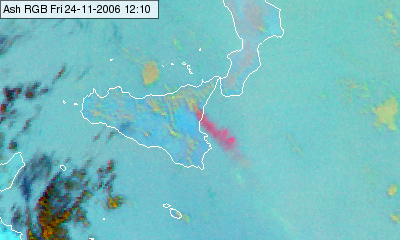Thin, pure volcanic ash cloud
Thin, pure volcanic ash clouds appear typically red or magenta in the Ash RGB images.
The thick volcanic ash cloud is not separable from other thick clouds. However, the ash plume becomes rapidly thinner with increasing distance from the source, and the semitransparent ash cloud is already detectable.
The image below shows one of the eruptions of Karthala volcano on the Grande Comore Island (near Madagascar). The volcano released significant amounts of volcanic ash.

Meteosat, SEVIRI Ash RGB for 25 November 2005 08:00 UTC
The image below shows an eruption of Mount Etna ejecting ash.

Meteosat, SEVIRI Ash RGB for 24 November 2006, 12:00 UTC
Ash clouds released by the Eyjafjallajökull volcano on Iceland are shown in the next image in reddish colours.

Meteosat, SEVIRI Ash RGB for 23 May 2011, 13:55 UTC (left) and 24 May 2011, 03:10 UTC (right)
The detection of thin ash cloud is particularly effective if the ash plumes
• reach high altitudes where the temperature difference between the ash cloud and the underlying surface is typically larger,
• does not contain significant number of ice particles,
• contain small ash particles.
Note that ash clouds with very mall ash particles at high viewing angles may appear yellow.
Explanation of the colours of thin, pure volcanic ash cloud (see the recipe):
The key channel combination of thin ash cloud detection is the (IR12.0-IR10.8) brightness temperature difference (visualised in the red colour beam). A thin ash cloud is more transparent in the 12.0 micrometer channel than in the 10.8 micrometer channel.
• For thin ash clouds the red component is high, (except the ash plume is mixed with a significant number of ice particles). For thin ice clouds the red signal is low; for thick clouds and cloud free land and sea it is medium strong.
• The green signal is week or medium strong, (except the ash is mixed with SO2 gas or it consists of very small particles and the viewing angles are high).
• The blue signal depends on the temperature and the transmittance of the ash plume, and the temperature of the underlying surface or cloud layer. For colder and denser ash clouds it is low, for warmer ash clouds it is high.
As a consequence the thin, pure ash cloud appears red or magenta (depending on the IR10.8 brightness temperature). It may appear yellow in case the ash particles are very small and the viewing angle is high. If the ash plume is mixed with an SO2 gas plume then it appears yellow.

